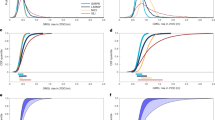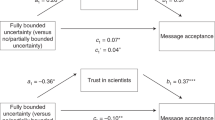Abstract
The Intergovernmental Panel on Climate Change (IPCC) uses verbal descriptions of uncertainty (for example, Unlikely) to convey imprecision in its forecasts and conclusions. Previous studies showed that the American public misinterprets these probabilistic statements. We report results from a multi-national study involving 25 samples in 24 countries and 17 languages. As predicted, laypeople interpret IPCC statements as conveying probabilities closer to 50% than intended by the IPCC authors. We show that an alternative presentation format supplementing the verbal terms with numerical ranges increases the correspondence between the public’s interpretations and the IPCC guidelines, and the terms are better differentiated. These qualitative patterns are remarkably stable across all samples and languages. In fact, interpretations of the terms in various languages are more similar under the new presentation format. These results suggest changing the way the IPCC communicates uncertainty.
This is a preview of subscription content, access via your institution
Access options
Subscribe to this journal
Receive 12 print issues and online access
$209.00 per year
only $17.42 per issue
Buy this article
- Purchase on Springer Link
- Instant access to full article PDF
Prices may be subject to local taxes which are calculated during checkout




Similar content being viewed by others
References
Pew Research Center for the People and the Press. Scientific achievements less prominent than a decade ago: Public praise science; Scientists fault public, media. (2009) http://www.people-press.org/files/legacy-pdf/528.pdf
Budescu, D. V. & Wallsten, T. S. in Judgmental Forecasting (eds Wright, G. & Ayton, P.) Subjective estimation of precise and vague uncertainties. 63–82 (Wiley, 1987).
Ha-Duong, M., Swart, R., Bernstein, L. & Petersen, R. Uncertainty management in the IPCC: agreeing to disagree. Glob. Environ. Change 17, 8–11 (2007).
Budescu, D. V., Broomell, S. B. & Por, H. H. Improving communication of uncertainty in the reports of the Intergovernmental Panel on Climate Change. Psych. Sci. 20, 299–308 (2009).
Budescu, D. V., Por, H. & Broomell, S. B. Effective communication of uncertainty in the IPCC reports: A nationally representative survey. Climatic Change 113, 181–200 (2012).
Wallsten, T. S. & Budescu, D. V. A review of human linguistic probability processing: general principles and empirical evidence. Knowl. Eng. Rev. 10, 43–62 (1995).
Teigen, K. H. & Brun, W. in Thinking: Psychological Perspectives on Reasoning, Judgment, and Decision Making (eds Hardman, D. & Macchi, L.) Verbal expressions of probability and uncertainty. 125–145 (Wiley, 2003).
Fischer, K. & Jungermann, H. Rarely occurring headaches and rarely occurring blindness: Is rarely = rarely? The meaning of verbal frequentistic labels in specific medical contexts. J. Behav. Decis. Mak. 9, 153–172 (1996).
Wallsten, T. S., Fillenbaum, S. & Cox, J. A. Base rate effects on the interpretations of probability and frequency expressions. J. Memory Lang. 25, 571–587 (1986).
Weber, E. U. & Hilton, D. J. Contextual effects in the interpretations of probability words: Perceived base rate and severity of events. J. Exp. Psychol.: Hum. Percep. Perform. 16, 781–789 (1990).
Fillenbaum, S., Wallsten, T. S., Cohen, B. L. & Cox, J. A. Some effects of vocabulary and communication task on the understanding and use of vague probability expressions. Am. J. Psychol. 104, 35–60 (1991).
Brun, W. & Teigen, K. H. Verbal probabilities: Ambiguous, context-dependent, or both? Organ. Behav. Hum. Dec. 41, 390–414 (1988).
Erev, I. & Cohen, B. L. Verbal versus numerical probabilities: Efficiency, biases, and the preference paradox. Organ. Behav. Hum. Dec. 45, 1–18 (1990).
Wallsten, T. S., Budescu, D. V., Zwick, R. & Kemp, S. M. Preferences and reasons for communicating probabilistic information in numerical or verbal terms. Bull. Psychonom. Soc. 31, 135–138 (1993).
Piercey, M. D. Motivated reasoning and verbal versus numerical probability assessment: Evidence from an accounting context. Organ. Behav. Hum. Dec. 108, 330–341 (2009).
Budescu, D. V., Weinberg, S. & Wallsten, T. S. Decisions based on numerically and verbally expressed uncertainties. J. Exp. Psychol.: Hum. Percep. Perform. 14, 281–294 (1988).
Budescu, D. V., Karelitz, T. M. & Wallsten, T. S. Predicting the directionality of probability words from their membership functions. J. Behav. Decis. Mak. 16, 159–180 (2003).
Zwick, R. & Wallsten, T. S. Combining stochastic uncertainty and linguistic inexactness: Theory and experimental evaluation of four fuzzy probability models. Int. J. Man-Machine Stud. 30, 69–111 (1989).
Beyth-Marom, R. How probable is probable? A numerical translation of verbal probability expressions. J. Forecast. 1, 257–269 (1982).
Clarke, V. A., Ruffin, C. L., Hill, D. J. & Beamen, A. L. Ratings of orally presented verbal expressions of probability by a heterogeneous sample. J. Appl. Soc. Psychol. 22, 638–656 (1992).
Reagan, R., Mosteller, F. & Youtz, C. Quantitative meanings of verbal probability expressions. J. Appl. Psychol. 74, 433–442 (1989).
Hamm, R. M. Selection of verbal probabilities: A solution for some problems of verbal probability expression. Organ. Behav. Hum. Dec. 48, 193–223 (1991).
Mosteller, F. & Youtz, C. Quantifying probabilistic expressions. Stat. Sci. 5, 2–16 (1990).
Smithson, M., Budescu, D. V., Broomell, S. B. & Por, H. H. Never say ‘not’: Impact of negative wording in probability phrases on imprecise probability judgments. Int. J. Approx. Reason. 53, 1262–1270 (2012).
Witteman, C. & Renooij, S. Evaluation of a verbal–numerical probability scale. Int. J. Approx. Reason. 33, 117–131 (2003).
Witteman, C., Renooij, S. & Koele, P. M. Medicine in words and numbers: a cross-sectional survey comparing probability assessment scales. BMC Med. Inform. 7 (2007).
InterAcademy Council. Climate change assessments: Review of the processes and procedures of the IPCC. (2010) http://reviewipcc.interacademycouncil.net
Heath, Y. & Gifford, R. Free-market ideology and environmental degradation: The case of belief in global climate change. Environ. Behav. 38, 48–71 (2006).
Dunlap, R. E., Van Liere, K. D., Mertig, A. G. & Jones, R. E. Measuring endorsement of the new ecological paradigm: A revised NEP scale. J. Soc. Issues 56, 425–442 (2000).
Thompson, S. C. G. & Barton, M. A. Ecocentric and anthropocentric attitudes toward the environment. J. Environ. Psychol. 14, 149–157 (1994).
Bord, R. J., O’Connor, R. E. & Fisher, A. In what sense does the public need to understand global climate change? Public Underst. Sci. 9, 205–218 (2000).
Weller, J. A., Dieckmann, N. F., Tusler, M., Mertz, C. K. & Burns, W. J. et al. Development and testing of an abbreviated numeracy scale: A Rasch analysis approach. J. Behav. Decis. Mak. 26, 198–212 (2012).
Leiserowitz, A., Smith, N. & Marlon, J.R. Americans’ knowledge of climate change. (Yale University, Yale Project on Climate Change Communication.)http://environment.yale.edu/climate/files/ClimateChangeKnowledge2010.pdf2010).
Acknowledgements
The work was supported by Grant no. 1125879 from the US National Science Foundation. The authors thank the local collaborators who translated and back translated the surveys and helped in local adjustments: W. Au (China and Hong Kong), M. Balassiano (Brazil), I. Barbopoulos (Sweden), J. Fuller (Korea), C. G. Vallejo (Chile), L. Hadar (Israel), A. Hansla (Sweden), E. Hölzl (Germany), Z. Hichy (Italy), M. Juanchich (France), A. Maydeu-Olivares (Spain), K. Nakamura (Japan), D. Őnkal (Turkey), M. Sirota (Slovakia), P. Śleboda (Poland), J. Sokolowska (Poland), G. Villejoubert (UK), C. Witteman (The Netherlands) and A. MacLean, for assistance in coordination of data collection.
Author information
Authors and Affiliations
Contributions
D.V.B.: initiated project, design, data analysis, and lead writer of the paper. H-H.P.: Coordinated data collection, design, data analysis, and writing. S.B.B.: Design, data analysis, and writing. M.S.: Data analysis and writing.
Corresponding author
Ethics declarations
Competing interests
The authors declare no competing financial interests.
Supplementary information
Rights and permissions
About this article
Cite this article
Budescu, D., Por, HH., Broomell, S. et al. The interpretation of IPCC probabilistic statements around the world. Nature Clim Change 4, 508–512 (2014). https://doi.org/10.1038/nclimate2194
Received:
Accepted:
Published:
Issue Date:
DOI: https://doi.org/10.1038/nclimate2194
This article is cited by
-
Climate change beliefs and their correlates in Latin America
Nature Communications (2023)
-
Dimensions of uncertainty communication: What is conveyed by verbal terms and numeric ranges
Current Psychology (2023)
-
Confidence levels and likelihood terms in IPCC reports: a survey of experts from different scientific disciplines
Climatic Change (2022)
-
Improving the usability of climate indicator visualizations through diagnostic design principles
Climatic Change (2021)
-
Communicating climate change findings from IPCC reports: insights from outreach events in India
Climatic Change (2021)



